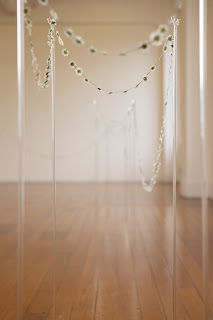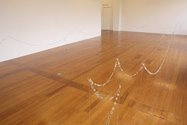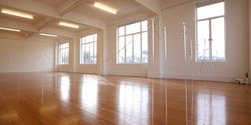John Hurrell – 18 May, 2009
This substantial loop made of hundreds of joined up (pressed) daisies, held aloft by over fifty glass stanchions, is a sight to behold. It is not optically spectacular - though it is beautifully understated and extremely fragile - but it is a clever idea.
This substantial loop made of hundreds of joined up (pressed) daisies, held aloft by over fifty glass stanchions, is a sight to behold. It is not optically spectacular - though it is beautifully understated and extremely fragile - but it is a clever idea. As a sagging ‘chain fence’ it mimics in its contours the floor plan of the large Physics Room gallery. Each of the thin transparent stanchions that keeps it in place is perfectly vertical, one end v-shaped to hold the thread of linked stems, the other firmly screwed into a hole drilled into the stained wooden floor.
This work however is more than structure. Its obsessiveness is part of the appeal, the nuttiness of its prolonged and exhausting labour - like say Wolfgang Laib and his jars of collected yellow pollen, the repetitive, cursively written sheets of the late Hanne Darboven, or the paintings of Roman Opalka with their painted rows of tiny numbers - only less extreme. Swanson’s is only for a single show, not a lifetime’s career.
By cordoning off the centre, the inner space of the gallery, Swanson creates a pathway around the edges, containing her audience and pressing them against the walls when they back away from the delicate barrier. The length of the frail chain is precisely judged so that its load-bearing ability is not pushed too far. As it dries it seems to become stronger and not brittle.
Swanson’s exhibition is quite wonderful in the way it takes a childhood game to create a sculpture of considerable psychological power. Hopefully word will get round so it gets the appreciation it deserves.
(Photos courtesy of the artist and Mark Gore.)
John Hurrell





 Two Rooms presents a program of residencies and projects
Two Rooms presents a program of residencies and projects Advertising in this column
Advertising in this column



This Discussion has 0 comments.
Comment
Participate
Register to Participate.
Sign in
Sign in to an existing account.